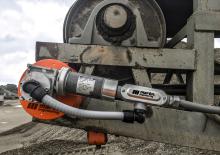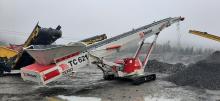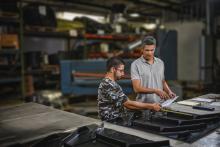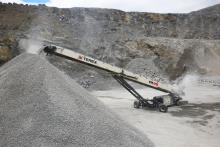
2022 has been another challenging year for manufacturers of conveying equipment, with cost increases coupled with component supply issues have been the biggest issues being the biggest problems.
That is the view of Darragh Cullen, MD of Northern Ireland-based conveyor and materials-handling equipment manufacturer EDGE Innovate, who adds that the challenges brought forward by availability of components have eased but only slightly.
“We have had to constantly adjust our production schedule to meet this ever-changing scenario,” says Cullen. “Ultimately, we have surpassed our output goals and targets, but the order in which equipment has been shipped to customers has had to be realigned. Issues at ports have been exacerbated by huge demand and strike action, which has placed further stress on delivery times.”
He says that the good news is that the challenges brought forward by COVID seem to be over, and life has more or less returned to normal: “The size and quality of our team have increased, and we have again invested heavily in product development and innovation. 2023 will see the launch of more new world-class, innovative products.
“Our order book has never been as healthy. We continue to challenge everything we do to improve efficiencies, machines design and customer support.”
Cullen says EDGE Innovate is looking to 2023 with excitement and determination. “We are building relationships with new partners and new markets but are more than thankful for the long-standing relationships and partnerships that we already have,” he adds.
Northern Ireland-based dry bulk materials-handling solutions manufacturer says that the needs of its customers have led to improvements across its quarrying operations. One example of this is the introduction of the ‘Self-Driving’ smart stockpiling solution found on Telestack’s radial telescopic conveying range. By deploying technology and experience, this advanced autonomous stockpiling solution aims to maximise returns within any operation, ensuring operational efficiency, improved site safety, reduced operational overheads and complexity, as well as a quality in-spec 'blended' product.
The Telestack radial telescopic conveyor range has a proven record of performance and reliability operating in a range of aggregates applications around the globe. The mobility options of the unit allow the operator to utilise this technology anywhere on site, ensuring a high production capacity and a 30% greater stockpile capacity on the same footprint when compared to fixed length/height conveyors. The smart system, once set up, can be operated locally by an operator or operated remotely using the smart onboard PLC (programmable logical controller) to feed information back to the remote central control station. Once the unit’s physical constraints are established, the unit can work independently using the pre-programmed parameters determined in the set-up.

The smart stockpiling system starts at a low working angle, such as 8°, maintaining its lowest workable drop height throughout the operation as the stockpile increases in increments. This is in comparison to a fixed length unit, for example, that would start at an 18° angle, thus wasting more energy to discharge the product at a greater height. In addition, this also results in a greater potential to compromise the quality of the product due to fracture and degradation of the product caused by material dropping from the elevated operating height. The reduced power usage required for the radial telescopic ensures less energy/fuel is used in the daily operation, and fuel consumption can be further enhanced with the introduction of an optional VSD (variable speed drive) by allowing the operator (remotely or locally) to increase or decrease the speed accordingly, depending on the needs of the operation.
Telestack says that the continuous autonomous stockpiling ensures that the blend of the product is maintained throughout the stockpile and a higher quality product is achievable, ensuring the product is evenly mixed over a wide area. This helps to eliminate segregation, degradation, contamination and compaction, providing not only a higher-grade product for a lower stockpiling cost per tonne but also reduced labour dependency and reduced labour costs as well as the environmental impact of reduced traffic, dust and noise. The smart system also hosts a range of automatic sensors that guide the independent unit as determined in the set-up. These sensors, as well as safeguarding the drop height of the product, also ensure that the unit will pause when the material has stopped flowing. This ensures the integrity of the continuous stockpile structure, producing an “in-spec” blended product. This would be a significant factor for many in the aggregates sector, for example, where product integrity is critical.
The Telestack range of radial telescopic stackers is available in lengths of 32m (110ft), 42m (140ft), 46m (150ft), 52m (170ft) and 58m (190ft) with possible stockpile capacities up to 200,000 tonnes at 270°. Stockpiling rates range from 100-3,000tph, and stockpile heights up to 20m (65ft) are easily achieved.
In addition, the option of several PLC automatic stockpiling programmes provides the operator with a versatile, economic and reliable stockpiling system that offers the ability for a radial window, incline window and radial conical stockpile formations, which, in all, offer a larger stockpiling potential and a radial stockpiling potential of up to 270° for maximum stockpiling. The smart stockpiling system controls the operation of the unit and gathers information, and sends it back to the central control station/ remote location. This helps to troubleshoot when issues arise, giving the controller operational information and specific status updates. In addition, the optional Telestack telematic system Telecore, offers remote monitoring and support from the factory to enhance performance. This has proven critical not only in the operational performance but also relating to the general maintenance of the unit. Particularly when labour was restricted, for example, during the recent COVID r
estrictions, the support from the factory was vital in supporting operations through challenging times.
The Telestack team will be in attendance at the forthcoming CONEXPO-CON/AGG 2023 in Vegas (14-18 March) on the Astec Industries Stand in Central Hall (Booth #C30235).
Mike Schroeder, technical consultant with ContiTech conveying solutions at US specialty belting manufacturer WCCO Belting, is sharing his two decades of experience at the company to set out the factors to consider when selecting a cleated conveyor belt and how a strategic approach to belt design can have drastic impacts to output and uptime.
Schroeder says the height of the cleat will be determined by the conveying angle and the size of the material being conveyed. Typically, conveying angles higher than 15° would benefit from a 0.50” (12.7mm)-tall cleat pattern (or more) to prevent spillback. Spillback creates unnecessary abrasion to the top cover of the belt in addition to decreasing capacity.
A cleat’s profile needs to have an adequate radius and chamfer features to prevent cleat cracking and tearing from the belt carcass. Most profiles will be drafted from the base to the top of the profile to help release it from the moulds post-vulcanisation. Fabricated cleated belts made via skiving and glueing have a higher tendency to delaminate and fail compared to single-step vulcanized manufacturing. Cleat ends, in most cases, are angled to prevent stress build-up around rollers and pulleys that can also lead to cleat failure, reduced capacity, and downtime.
“Aggregate material has an abrasive texture. However, almost all industry ‘V’ or ‘U’ cleat profiles are encouraging material movement directing it to the centre of the belt,” says Schroeder. “This results in unnecessary wear and tear on the belt cover, such as high wear points, plus stress on the cleats. Spillage is one symptom of the cleat’s inability to capture and hold product effectively.”

He adds that the angle of the cleat in relation to the drive and tail pulleys is critical. Too little angle (parallel to the roller) and cleat chatter develops from a lack of continuous contact between the rollers and cleat profile, bringing excessive vibration, noise, and eventually, cleat failure. If the cleat angle to the rollers is too large (perpendicular to the roller), cleat cracking can ensue, followed by cleat tear and separation from the belt carcass. Furthermore, cleat height in conjunction with angle will determine the minimum pulley diameter the belt requires to operate. Taller cleats with large angles to the rollers will experience higher bending stress and are at greater risk of cracking and tearing.
The individual cleats will be laid out across the width of the belt. Cleat frequency refers to the repeated pattern down the length of the belt. The frequency by which the cleats repeat is critical in creating a fully nested pattern. A nested cleat pattern allows for a smooth transition over rollers and pulleys, thereby reducing premature cleat wear and belt failure.
In terms of other considerations, Schroeder says the belt construction itself with the cleat pattern must be able to trough appropriately given application requirements. The flexibility prevents mis-tracking, premature wear, and belt failure. In troughed systems, the belt must be able to make correct contact with the guide rollers when operating under load or empty.
“Cleat profile design is tied to the conveyor system’s discharge,” he adds. “If the discharge stream needs to be small or targeted, the pattern can support material movement to the centre of the belt. Another consideration is if moisture build-up would prevent the success of the operation. An open-type pattern can allow for drainage through the cleat pattern.”
In summary, Schroeder says the ideal cleated conveyor belt will have the cleat height needed based on the material size and conveying angle. The cleat profile should be designed with optimum features to ensure the longevity and performance of the cleats, which impacts operational capacity and uptime. The cleat pattern should be nested and make continuous contact with return rollers to allow the system to operate with limited noise and vibration for a smooth operation. The more continuous contact points on the return rollers, the better the belt and the system will operate.
“If price remains the decision-driver to purchase a conveyor belt and belt design isn’t approached as a strategy, equipment owners and operators will continue to leave a lot on the table,” says Schroeder. “Working with a belting expert on your unique operating requirements can help you learn how your cleated belt is working for you and, more importantly, how it’s not.”
Martin Engineering is highlighting the importance of proper conveyor cleaner blade tensioning, the types of tensioners, and some of the best uses for each. The US bulk materials-handling company says that there are many issues to consider when specifying the most appropriate conveyor belt cleaner, not the least of which is maintaining proper tension to achieve optimum cleaning performance without introducing related problems. Inadequate tensioning causes carryback to cling to the belt and spill along its path, piling up under the conveyor and emitting excessive dust. This requires extra labour for clean-up and can affect air quality. Over-tensioning leads to friction damage to the carrying side of the belt, premature blade wear and potential splice damage. Both scenarios contribute to unsafe work conditions and raise the cost of operation.
“There are two basic approaches to applying tension to the belt cleaner: linear and rotary,” Mueller continued. “The blade’s cleaning position and angle of approach to the belt often dictate whether a linear or rotary tensioner is used.”
The Conveyor Equipment Manufacturers Association (CEMA) defines the cleaning positions as primary, secondary, or tertiary. Primary cleaners typically function with a “peeling” action, while secondary and tertiary cleaners are usually scrapers. Belt cleaners mounted in the primary position generally employ a rotary style tensioner, while most units mounted in the secondary or tertiary positions use linear style tensioners.
In most cases, belt tensioners have to be monitored and adjusted manually so they can maintain optimum pressure and carryback removal. Estimating when blades need changing is often a guessing game that, if left too long, could lead to unnecessary complications.
“Linear tensioners are most often applied where the compensation for wear is required in small increments, such as with hard metal-tipped cleaners located in the secondary cleaning position or with brush cleaners,” Mueller said.
The simple design of linear tensioners often allows just one setting for full blade wear. Further, these tensioners can accommodate actuator deflection for accurate adjustment of cleaning pressure, delivering the ability to accommodate uneven mounting positions or asymmetrical blade wear.
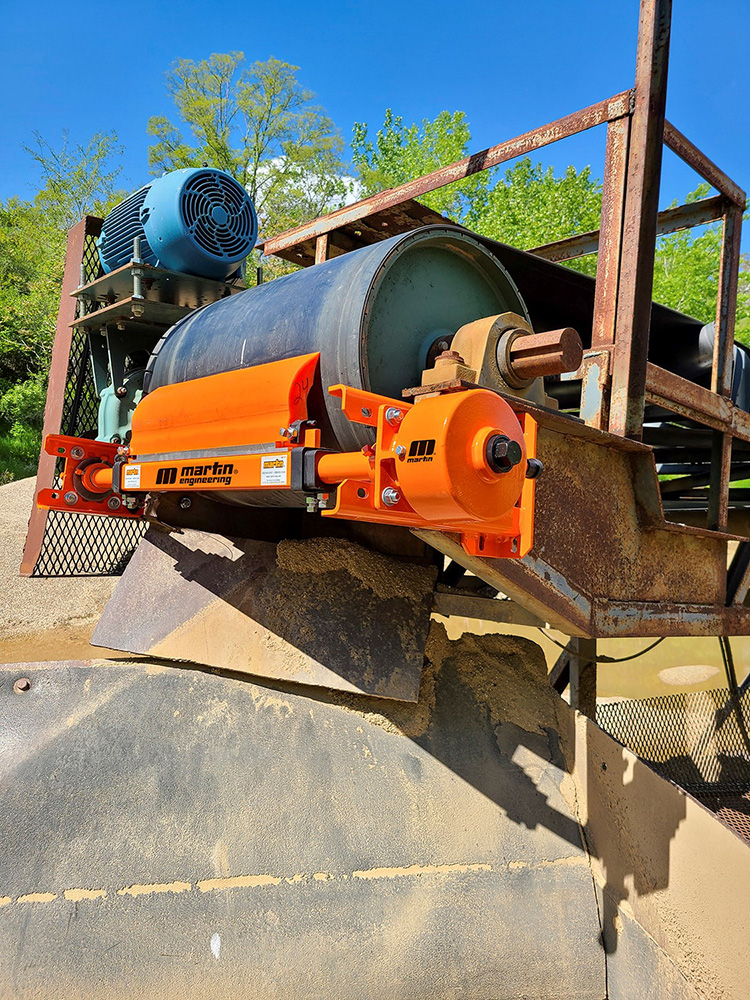
The required tensioning forces can be applied by springs, hydraulic or pneumatic cylinders, electric actuators or from torque stored in an elastomeric element. Rotary tensioners like the Martin Twist Tensioner are often used with urethane blades, where the change in blade height and thickness as it wears is significant. Rotary designs tend to be compact and, in most cases, the actuator(s) can be mounted at any orientation, which provides options for installing the belt cleaner in the optimum position.
Air tensioners use the resilience of a pneumatic cylinder to cushion impact. The tensioners can use Martin’s Air Connection Kit to plug them directly into an existing air system, allowing for a more streamlined installation process.
Spring tensioners maintain efficient belt cleaning with a rugged coil spring. The Martin XHD Spring Tensioners deliver effective cleaning while cushioning splice shock to prevent damage, well suited for tensioning heavy duty belt cleaners while standing up to tough conditions. Dual tensioning is recommended for belt cleaners installed on belts wider than 1,200mm. However, dual tensioning does not change the fact that regular adjustment is required to maintain suitable cleaning pressure on the belt, which is where Martin’s N2® Smart Technology comes into play.
Martin Engineering’s smart technology platform includes the company’s patented N2 Position Indicator to monitor primary cleaner blade wear and inform operators when the blade needs changing. The system uses a cellular gateway that relays data to the cloud and then to the user, delivering actionable information in real-time.
The N2 PI and Smart Device Manager App are designed to ease the burden on managers and workers so they can focus their attention on other critical details of the operation. Precise tensioning and improved belt cleaning reduce the volume of dust and spillage from carryback, improving workplace conditions and decreasing the labour needed to maintain and clean around the discharge zone.
While manufacturers continue to improve belt cleaner effectiveness, it has become clear that there is no single or ideal solution for belt cleaning and tensioner selection. The safety of personnel and the belt itself is the primary consideration when selecting a tensioner. Ease of inspection and maintenance is critical for belt cleaner effectiveness, so the tensioner must allow quick and safe service. Martin Engineering offers the services and tensioning products that are necessary to meet the multifaceted demands of belt cleaning.

